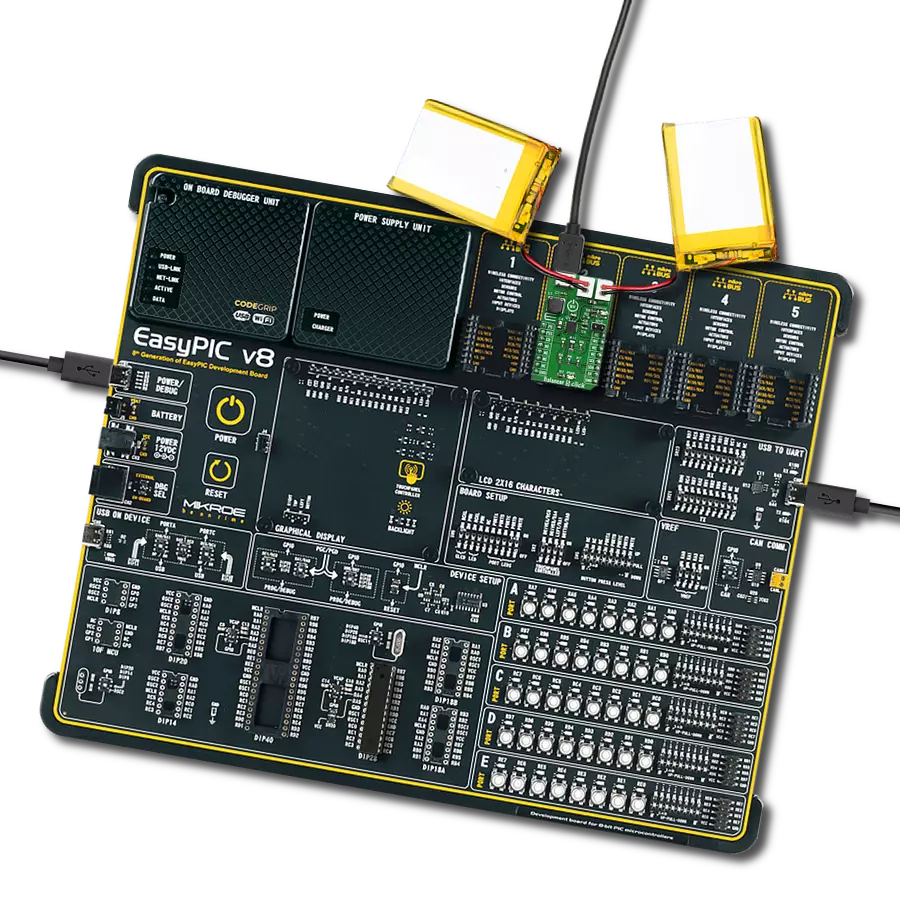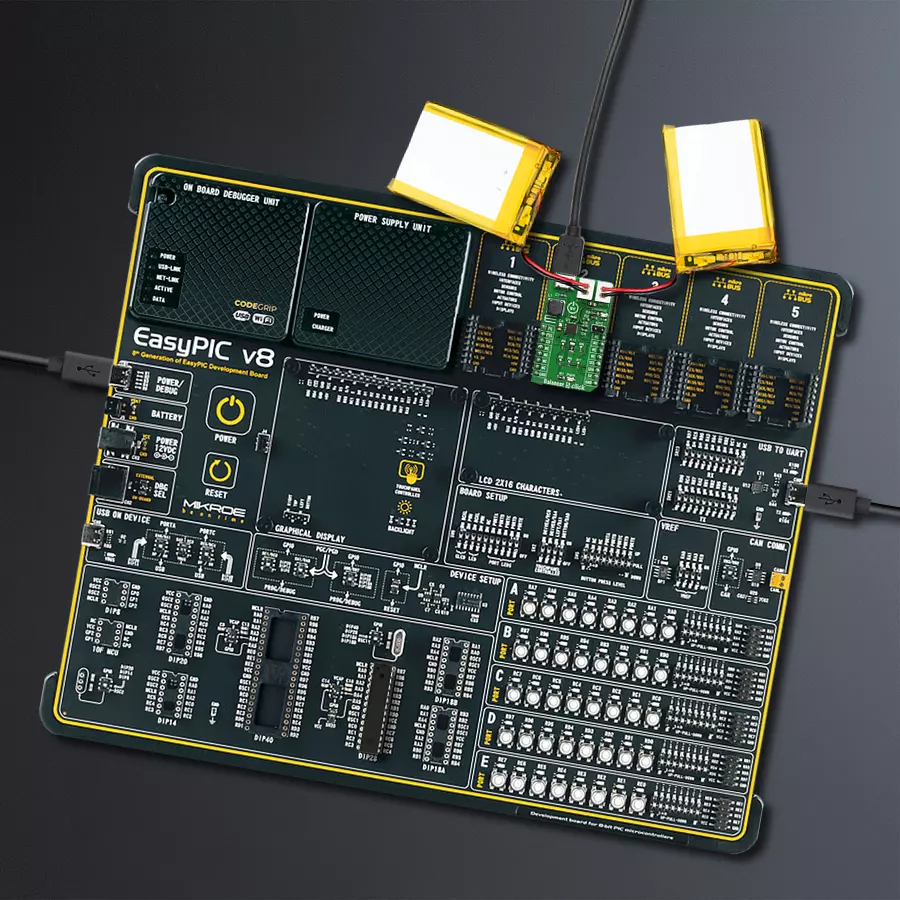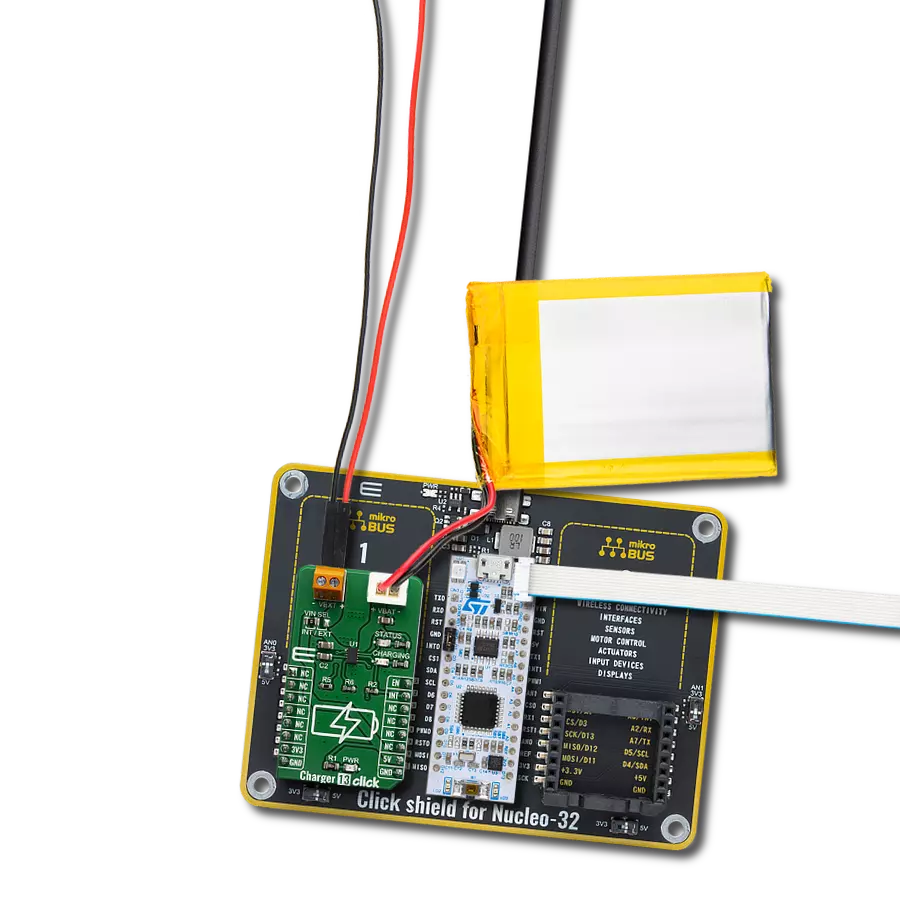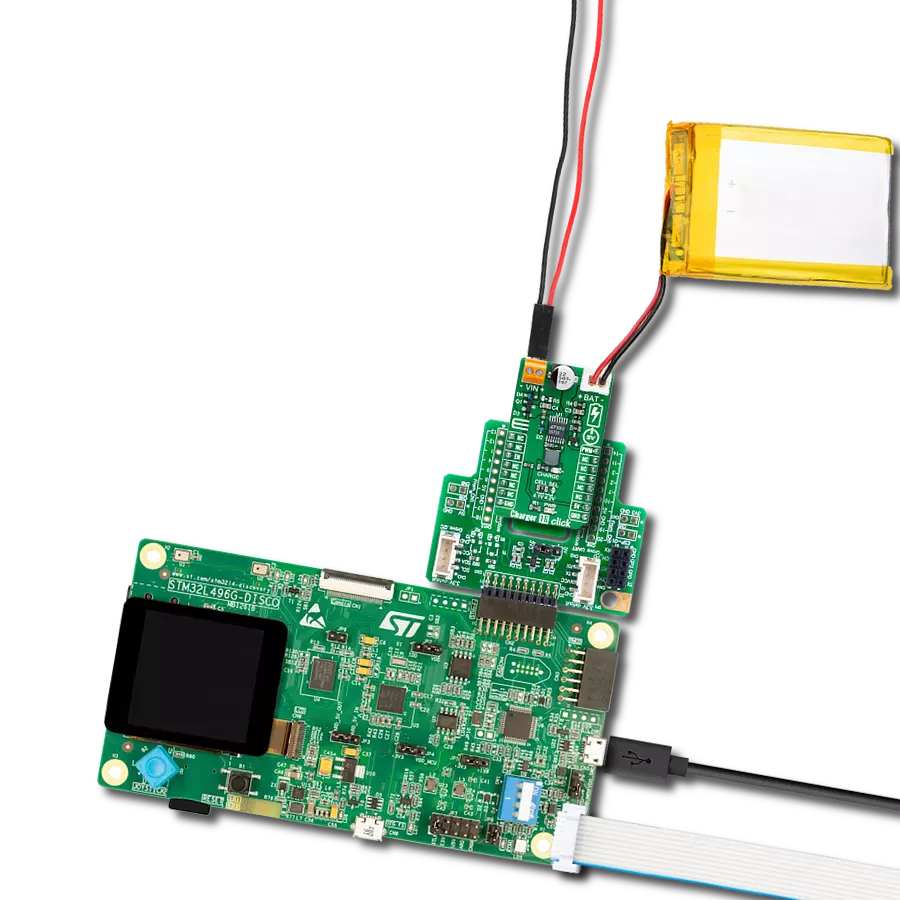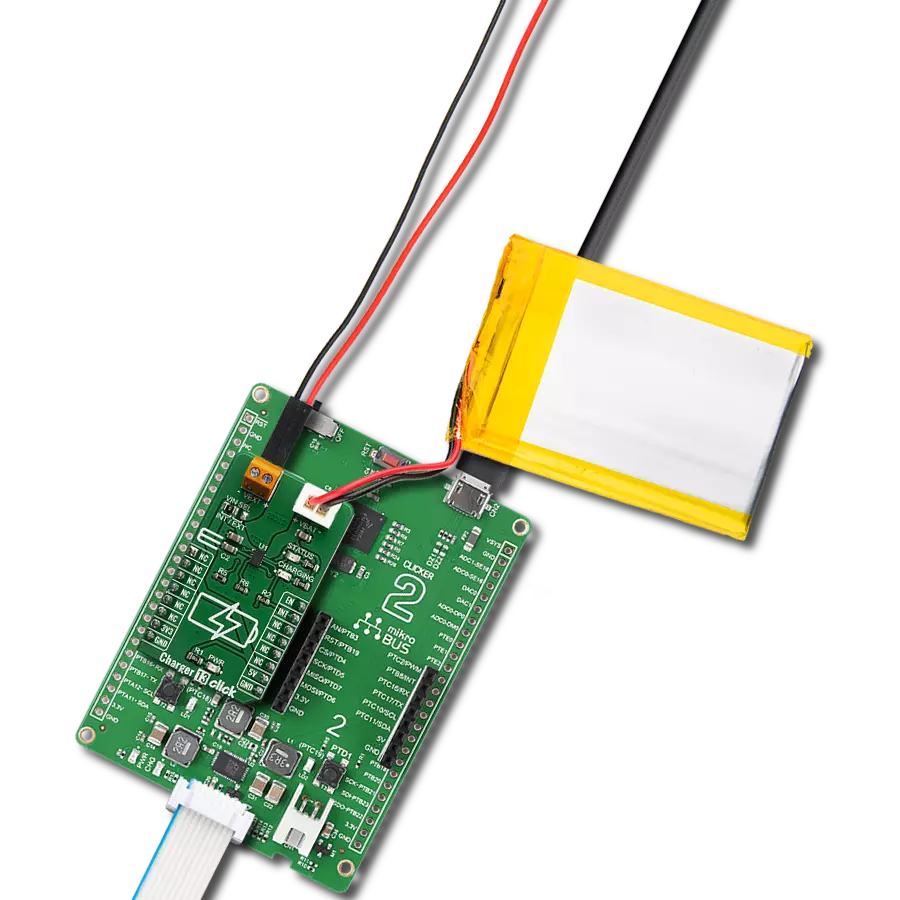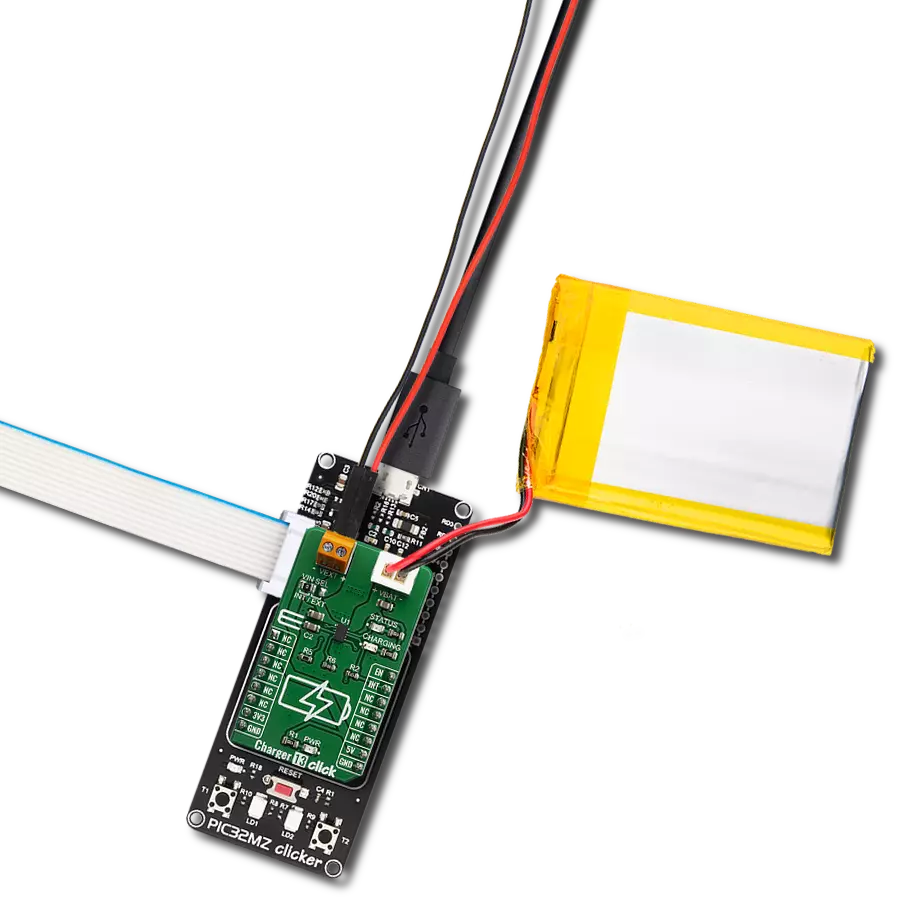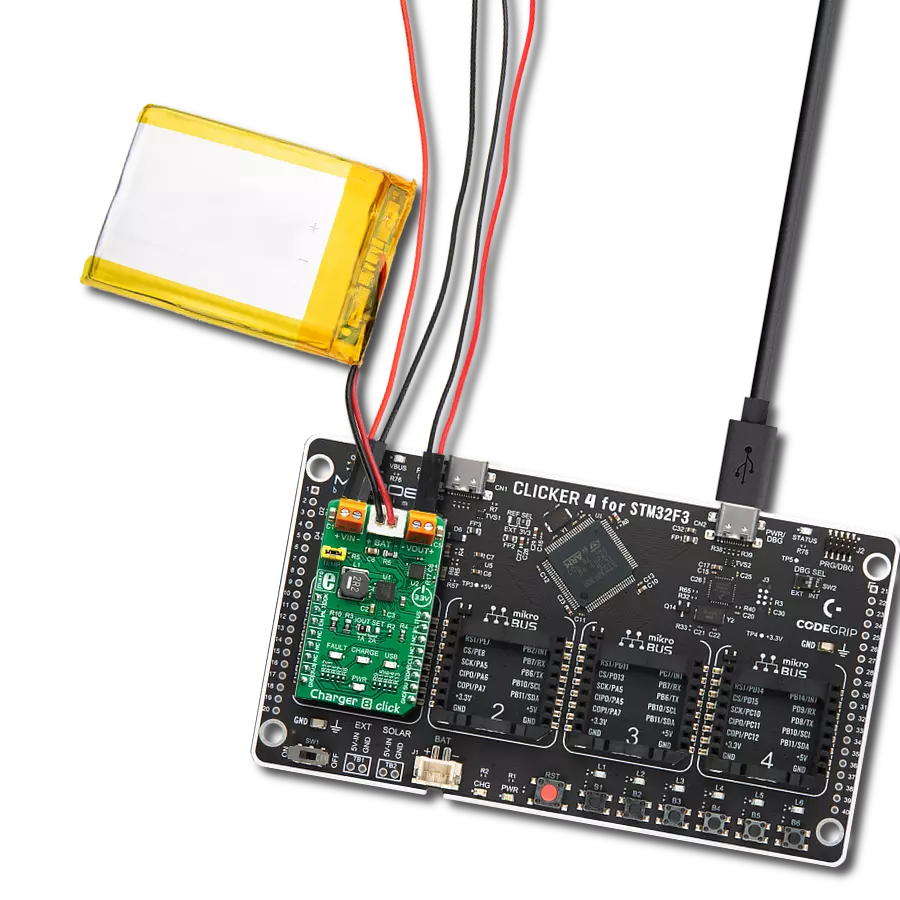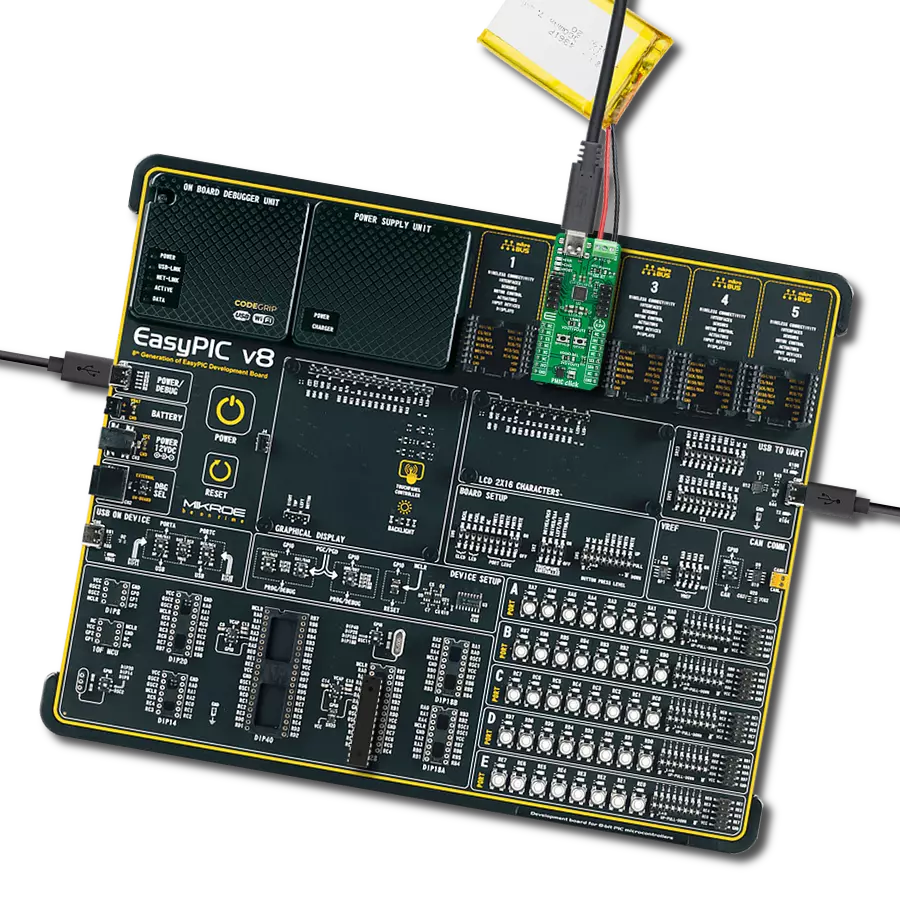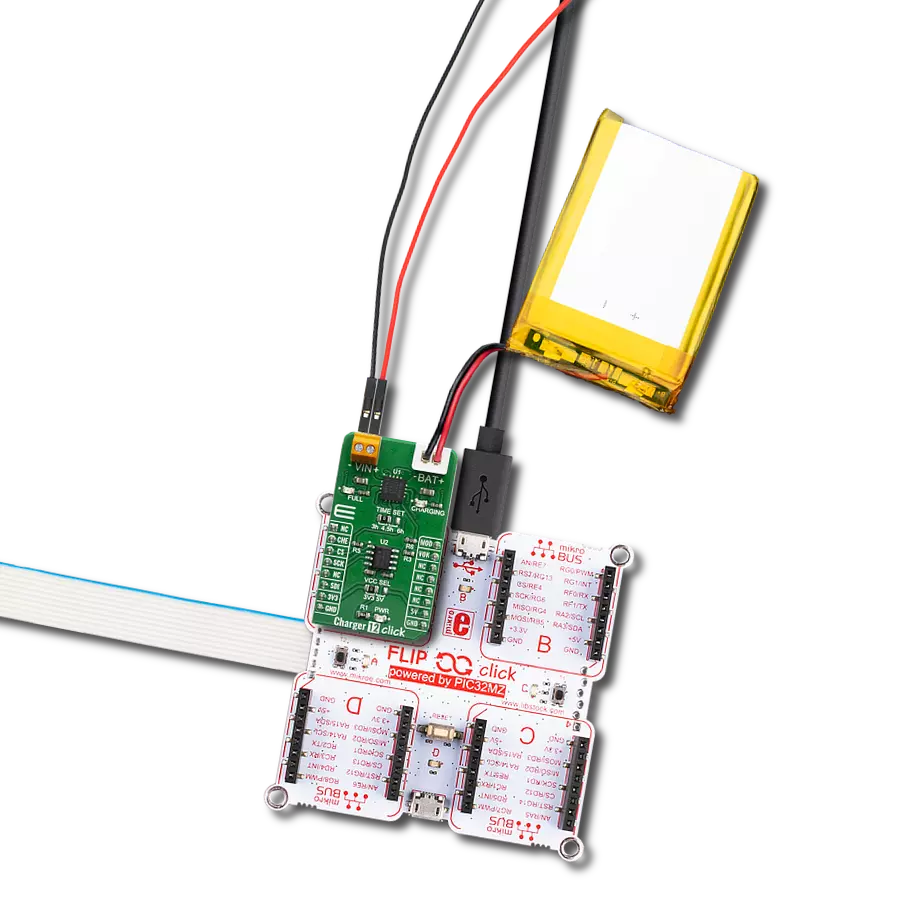The perfect companion for portable power with integrated cell balancing!
A
A
Hardware Overview
How does it work?
Balancer 5 Click is based on the BQ25887, a fully integrated 2-cell Li-ion battery charger from Texas Instruments, ideal for portable applications with cell balancing. The BQ25887 optimizes the charging of two batteries with balancing. The input voltage range from the USB connector can be as high as 5.5V; the battery can be charged up to 3.3A. When the input voltage exceeds the OVP (Over Voltage Protection) threshold, it will turn off the charging MOSFET to avoid overheating the chip. Besides its small physical size, the low number of external components makes this IC ideal for various applications. As Lithium Ion batteries require a very accurate current and voltage for charging, Balancer 5 click can be a perfect solution for such a task. Balancer 5 Click is equipped with a highly integrated Li-Ion battery charger, supporting intelligent, constant-current, constant
voltage (CCCV), a temperature-regulated battery charger that charges 2-cell lithium-ion (Li+) cell batteries. This Click has a charging current control IC over the I2C interface, which ensures perfect and efficient charging. Balancer 5 Click can be part of the power supply and distribution system in many applications: handheld appliances, portable media players, portable audio players, and other general-purpose battery-operated electronic devices. On the left side of the click board is an input USB connector, where an external voltage as high as 5.5V can be applied. Two connectors on the right side are reserved for Li-Ion batteries with corresponding markings; the right connector is for the first batteries, and the left connector is for the second batteries. When connected to a power source, the green CHARGE LED will indicate it, and LOW indicates the charge in progress.
HIGH indicates the charge is complete or disabled. When any fault occurs, the STAT pin blinks at 1Hz. The STAT function can be turned off when the STAT_DIS bit is set. On the right side is a 1x2 male header for connecting an NTC (Negative temperature Coefficient) resistor. Connect a negative temperature coefficient thermistor and program temperature window with a resistor divider from REGN to TS to GND. The charge suspends when the TS pin is out of range. Recommend 103AT-2 thermistor. This Click board™ can only be operated with a 5V logic voltage level. The board must perform appropriate logic voltage level conversion before using MCUs with different logic levels. However, the Click board™ comes equipped with a library containing functions and an example code that can be used as a reference for further development.
Features overview
Development board
EasyPIC v8 is a development board specially designed for the needs of rapid development of embedded applications. It supports many high pin count 8-bit PIC microcontrollers from Microchip, regardless of their number of pins, and a broad set of unique functions, such as the first-ever embedded debugger/programmer. The development board is well organized and designed so that the end-user has all the necessary elements, such as switches, buttons, indicators, connectors, and others, in one place. Thanks to innovative manufacturing technology, EasyPIC v8 provides a fluid and immersive working experience, allowing access anywhere and under any
circumstances at any time. Each part of the EasyPIC v8 development board contains the components necessary for the most efficient operation of the same board. In addition to the advanced integrated CODEGRIP programmer/debugger module, which offers many valuable programming/debugging options and seamless integration with the Mikroe software environment, the board also includes a clean and regulated power supply module for the development board. It can use a wide range of external power sources, including a battery, an external 12V power supply, and a power source via the USB Type-C (USB-C) connector.
Communication options such as USB-UART, USB DEVICE, and CAN are also included, including the well-established mikroBUS™ standard, two display options (graphical and character-based LCD), and several different DIP sockets. These sockets cover a wide range of 8-bit PIC MCUs, from the smallest PIC MCU devices with only eight up to forty pins. EasyPIC v8 is an integral part of the Mikroe ecosystem for rapid development. Natively supported by Mikroe software tools, it covers many aspects of prototyping and development thanks to a considerable number of different Click boards™ (over a thousand boards), the number of which is growing every day.
Microcontroller Overview
MCU Card / MCU
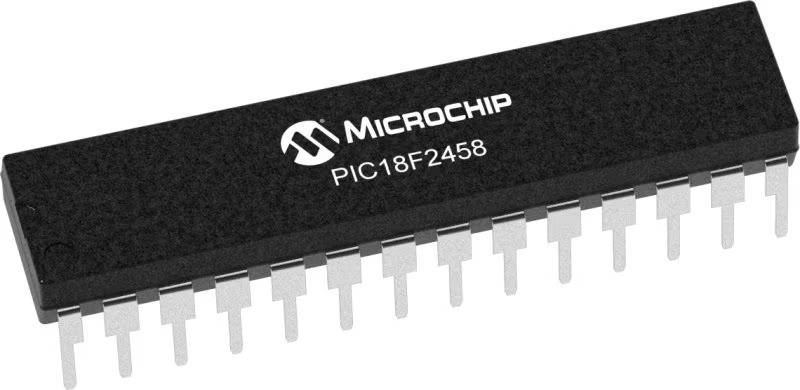
Architecture
PIC
MCU Memory (KB)
24
Silicon Vendor
Microchip
Pin count
28
RAM (Bytes)
2048
You complete me!
Accessories
Li-Polymer Battery is the ideal solution for devices that demand a dependable and long-lasting power supply while emphasizing mobility. Its compatibility with mikromedia boards ensures easy integration without additional modifications. With a voltage output of 3.7V, the battery meets the standard requirements of many electronic devices. Additionally, boasting a capacity of 2000mAh, it can store a substantial amount of energy, providing sustained power for extended periods. This feature minimizes the need for frequent recharging or replacement. Overall, the Li-Polymer Battery is a reliable and autonomous power source, ideally suited for devices requiring a stable and enduring energy solution. You can find a more extensive choice of Li-Polymer batteries in our offer.
Used MCU Pins
mikroBUS™ mapper
Take a closer look
Click board™ Schematic

Step by step
Project assembly
Track your results in real time
Application Output
1. Application Output - In Debug mode, the 'Application Output' window enables real-time data monitoring, offering direct insight into execution results. Ensure proper data display by configuring the environment correctly using the provided tutorial.

2. UART Terminal - Use the UART Terminal to monitor data transmission via a USB to UART converter, allowing direct communication between the Click board™ and your development system. Configure the baud rate and other serial settings according to your project's requirements to ensure proper functionality. For step-by-step setup instructions, refer to the provided tutorial.

3. Plot Output - The Plot feature offers a powerful way to visualize real-time sensor data, enabling trend analysis, debugging, and comparison of multiple data points. To set it up correctly, follow the provided tutorial, which includes a step-by-step example of using the Plot feature to display Click board™ readings. To use the Plot feature in your code, use the function: plot(*insert_graph_name*, variable_name);. This is a general format, and it is up to the user to replace 'insert_graph_name' with the actual graph name and 'variable_name' with the parameter to be displayed.

Software Support
Library Description
This library contains API for Balancer 5 Click driver.
Key functions:
balancer5_charge- This function sets charging status
Open Source
Code example
The complete application code and a ready-to-use project are available through the NECTO Studio Package Manager for direct installation in the NECTO Studio. The application code can also be found on the MIKROE GitHub account.
/*!
* \file
* \brief Balancer5 Click example
*
* # Description
* This example demonstrates basic Balancer 5 Click functionalities.
*
* The demo application is composed of two sections :
*
* ## Application Init
* Initializes Click and Driver, Checks Device ID, starts charging,
* reads charge status registers and configures ADC.
*
* ## Application Task
* Reads ADC values from registers and logs it.
*
* ## Additional function
* void charger_status_1_handler ( uint8_t cs1_data );
* void charger_status_2_handler ( uint8_t cs2_data );
*
* \author MikroE Team
*
*/
// ------------------------------------------------------------------- INCLUDES
#include "board.h"
#include "log.h"
#include "balancer5.h"
// ------------------------------------------------------------------ VARIABLES
static balancer5_t balancer5;
static log_t logger;
static uint8_t temp_data;
static uint16_t temp_uint_data;
static float temp_float_data;
// ------------------------------------------------------- ADDITIONAL FUNCTIONS
void charger_status_1_handler ( uint8_t cs1_data )
{
uint8_t charge = 0;
log_printf( &logger, "* CHARGER STATUS 1 :\r\n" );
if ( ( cs1_data & BALANCER5_CS1_IINDPM_IN_REGULATION ) == BALANCER5_CS1_IINDPM_IN_REGULATION )
{
log_printf( &logger, " - IINDPM_IN_REGULATION" );
}
else
{
log_printf( &logger, " - IINDPM_NORMAL" );
}
if ( ( cs1_data & BALANCER5_CS1_VINDPM_IN_REGULATION ) == BALANCER5_CS1_VINDPM_IN_REGULATION )
{
log_printf( &logger, " - VINDPM_IN_REGULATION" );
}
else
{
log_printf( &logger, " - VINDPM_NORMAL" );
}
if ( ( cs1_data & BALANCER5_CS1_IC_IN_THERMAL_REGULATION ) == BALANCER5_CS1_IC_IN_THERMAL_REGULATION )
{
log_printf( &logger, " - IC_IN_THERMAL_REGULATION" );
}
else
{
log_printf( &logger, " - IC_NORMAL" );
}
if ( ( cs1_data & BALANCER5_CS1_WD_TIMER_EXPIRED ) == BALANCER5_CS1_WD_TIMER_EXPIRED )
{
log_printf( &logger, " - WD_TIMER_EXPIRED" );
}
else
{
log_printf( &logger, " - WD_NORMAL" );
}
if ( ( cs1_data & BALANCER5_CS1_TRICKLE_CHARGE ) == BALANCER5_CS1_TRICKLE_CHARGE )
{
charge++;
log_printf( &logger, " - TRICKLE_CHARGE" );
}
if ( ( cs1_data & BALANCER5_CS1_PRE_CHARGE ) == BALANCER5_CS1_PRE_CHARGE )
{
charge++;
log_printf( &logger, " - PRE_CHARGE" );
}
if ( ( cs1_data & BALANCER5_CS1_FAST_CHARGE ) == BALANCER5_CS1_FAST_CHARGE )
{
charge++;
log_printf( &logger, " - FAST_CHARGE" );
}
if ( ( cs1_data & BALANCER5_CS1_TAPER_CHARGE ) == BALANCER5_CS1_TAPER_CHARGE )
{
charge++;
log_printf( &logger, " - TAPER_CHARGE" );
}
if ( ( cs1_data & BALANCER5_CS1_TOP_OFF_TIMER_CHARGE ) == BALANCER5_CS1_TOP_OFF_TIMER_CHARGE )
{
charge++;
log_printf( &logger, " - TOP_OFF_TIMER_CHARG" );
}
if ( ( cs1_data & BALANCER5_CS1_CHARGE_TERMINATION ) == BALANCER5_CS1_CHARGE_TERMINATION )
{
charge++;
log_printf( &logger, " - CHARGE_TERMINATION" );
}
if ( charge == 0 )
{
log_printf( &logger, " - NOT_CHARGING" );
}
}
void charger_status_2_handler ( uint8_t cs2_data )
{
uint8_t power_in = 0;
log_printf( &logger, "\r\n* CHARGER STATUS 2 :\r\n" );
if ( ( cs2_data & BALANCER5_CS2_MAX_INPUT ) == BALANCER5_CS2_MAX_INPUT )
{
log_printf( &logger, " - MAX_INPUT" );
}
else if ( ( cs2_data & BALANCER5_CS2_ICO_OPTIMIZATION_IN_PROGRESS ) == BALANCER5_CS2_ICO_OPTIMIZATION_IN_PROGRESS )
{
log_printf( &logger, " - ICO_OPTIMIZATION_IN_PROGRESS" );
}
else
{
log_printf( &logger, " - ICO_DISABLED" );
}
if ( ( cs2_data & BALANCER5_CS2_POWER_GOOD ) == BALANCER5_CS2_POWER_GOOD )
{
log_printf( &logger, " - POWER_GOOD" );
}
else
{
log_printf( &logger, " - POWER_NOT_GOOD" );
}
if ( ( cs2_data & BALANCER5_CS2_NON_STANDARD_ADAPTER ) == BALANCER5_CS2_NON_STANDARD_ADAPTER )
{
power_in++;
log_printf( &logger, " - NON_STANDARD_ADAPTER" );
}
if ( ( cs2_data & BALANCER5_CS2_UNKNOWN_ADAPTER ) == BALANCER5_CS2_UNKNOWN_ADAPTER )
{
power_in++;
log_printf( &logger, " - UNKNOWN_ADAPTER" );
}
if ( ( cs2_data & BALANCER5_CS2_POORSRC ) == BALANCER5_CS2_POORSRC )
{
power_in++;
log_printf( &logger, " - POORSRC" );
}
if ( ( cs2_data & BALANCER5_CS2_ADAPTER ) == BALANCER5_CS2_ADAPTER )
{
power_in++;
log_printf( &logger, " - ADAPTER" );
}
if ( ( cs2_data & BALANCER5_CS2_USB_CDP ) == BALANCER5_CS2_USB_CDP )
{
power_in++;
log_printf( &logger, " - CS2_USB_CDP" );
}
if ( ( cs2_data & BALANCER5_CS2_USB_HOST_SDP ) == BALANCER5_CS2_USB_HOST_SDP )
{
power_in++;
log_printf( &logger, " - USB_HOST_SDP" );
}
if ( power_in == 0 )
{
log_printf( &logger, " - NO_INPUT" );
}
}
// ------------------------------------------------------ APPLICATION FUNCTIONS
void application_init ( void )
{
log_cfg_t log_cfg;
balancer5_cfg_t cfg;
/**
* Logger initialization.
* Default baud rate: 115200
* Default log level: LOG_LEVEL_DEBUG
* @note If USB_UART_RX and USB_UART_TX
* are defined as HAL_PIN_NC, you will
* need to define them manually for log to work.
* See @b LOG_MAP_USB_UART macro definition for detailed explanation.
*/
LOG_MAP_USB_UART( log_cfg );
log_init( &logger, &log_cfg );
log_info( &logger, "---- Application Init ----" );
// Click initialization.
balancer5_cfg_setup( &cfg );
BALANCER5_MAP_MIKROBUS( cfg, MIKROBUS_1 );
balancer5_init( &balancer5, &cfg );
// Device ID sanity check
temp_data = balancer5_check_id( &balancer5 );
if ( temp_data == BALANCER5_ERROR_ID )
{
log_info( &logger, "ID ERROR!!!" );
for ( ; ; );
}
log_info( &logger, "***** ID OK *****" );
// Switch charger on
balancer5_charge( &balancer5, BALANCER5_CHARGE_ON );
// Send configuration info to logger
temp_data = balancer5_read_data( &balancer5, BALANCER5_REG_CHARGER_STATUS_1 );
charger_status_1_handler( temp_data );
temp_data = balancer5_read_data( &balancer5, BALANCER5_REG_CHARGER_STATUS_2 );
charger_status_2_handler( temp_data );
// Set default configuration
balancer5_default_cfg ( &balancer5 );
}
void application_task ( void )
{
temp_data = balancer5_read_data( &balancer5, BALANCER5_REG_IBUS_ADC1 );
temp_uint_data = temp_data;
temp_uint_data <<= 8;
temp_data = balancer5_read_data( &balancer5, BALANCER5_REG_IBUS_ADC0 );
temp_uint_data |= temp_data;
log_printf( &logger, "- IBUS: %umA\r\n", temp_uint_data );
temp_data = balancer5_read_data( &balancer5, BALANCER5_REG_ICHG_ADC1 );
temp_uint_data = temp_data;
temp_uint_data <<= 8;
temp_data = balancer5_read_data( &balancer5, BALANCER5_REG_ICHG_ADC0 );
temp_uint_data |= temp_data;
log_printf( &logger, "- ICHG: %umA\r\n", temp_uint_data );
temp_data = balancer5_read_data( &balancer5, BALANCER5_REG_VBAT_ADC1 );
temp_uint_data = temp_data;
temp_uint_data <<= 8;
temp_data = balancer5_read_data( &balancer5, BALANCER5_REG_VBAT_ADC0 );
temp_uint_data |= temp_data;
log_printf( &logger, "- VBAT: %umV\r\n", temp_uint_data );
temp_data = balancer5_read_data( &balancer5, BALANCER5_REG_VBUS_ADC1 );
temp_uint_data = temp_data;
temp_uint_data <<= 8;
temp_data = balancer5_read_data( &balancer5, BALANCER5_REG_VBUS_ADC0 );
temp_uint_data |= temp_data;
log_printf( &logger, "- VBUS: %umV\r\n", temp_uint_data );
temp_data = balancer5_read_data( &balancer5, BALANCER5_REG_VCELLTOP_ADC1 );
temp_uint_data = temp_data;
temp_uint_data <<= 8;
temp_data = balancer5_read_data( &balancer5, BALANCER5_REG_VCELLTOP_ADC0 );
temp_uint_data |= temp_data;
log_printf( &logger, "- VCELLTOP: %umV\r\n", temp_uint_data );
temp_data = balancer5_read_data( &balancer5, BALANCER5_REG_VCELLBOT_ADC1 );
temp_uint_data = temp_data;
temp_uint_data <<= 8;
temp_data = balancer5_read_data( &balancer5, BALANCER5_REG_VCELLBOT_ADC0 );
temp_uint_data |= temp_data;
log_printf( &logger, "- VCELLBOT: %umV\r\n", temp_uint_data );
temp_data = balancer5_read_data( &balancer5, BALANCER5_REG_TS_ADC1 );
temp_uint_data = temp_data;
temp_uint_data <<= 8;
temp_data = balancer5_read_data( &balancer5, BALANCER5_REG_TS_ADC0 );
temp_uint_data |= temp_data;
temp_float_data = temp_uint_data;
temp_float_data *= 0.098;
log_printf( &logger, "- TS: %.2f%%\r\n", temp_float_data );
temp_data = balancer5_read_data( &balancer5, BALANCER5_REG_TDIE_ADC1 );
temp_uint_data = temp_data;
temp_uint_data <<= 8;
temp_data = balancer5_read_data( &balancer5, BALANCER5_REG_TDIE_ADC0 );
temp_uint_data |= temp_data;
temp_float_data = temp_uint_data;
temp_float_data *= 0.5;
log_printf( &logger, "- TDIE: %.2f degC\r\n", temp_float_data );
log_printf( &logger, "____________________\r\n" );
Delay_ms ( 1000 );
Delay_ms ( 1000 );
Delay_ms ( 1000 );
Delay_ms ( 1000 );
Delay_ms ( 1000 );
}
int main ( void )
{
/* Do not remove this line or clock might not be set correctly. */
#ifdef PREINIT_SUPPORTED
preinit();
#endif
application_init( );
for ( ; ; )
{
application_task( );
}
return 0;
}
// ------------------------------------------------------------------------ END
